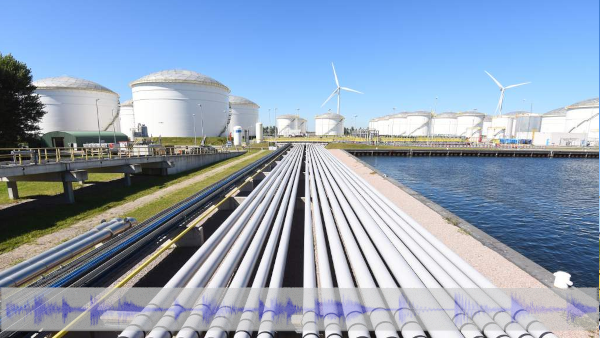 Statistically, operations face equipment degradation every 12 months, especially hard-use equipment, like pumps. Your storage terminal facility is looking at a 50% increase in repair costs, increased downtime, and shutdowns for when your essential assets fail.
Statistically, operations face equipment degradation every 12 months, especially hard-use equipment, like pumps. Your storage terminal facility is looking at a 50% increase in repair costs, increased downtime, and shutdowns for when your essential assets fail.
Corrosion is one of the biggest challenges that Storage Terminal operators face in the field when it comes to maintaining operation reliability. Areas like tank bottoms, pumping equipment, pipe supports and in-between the pipping which can be more difficult to assess, are all susceptible to corrosion. The only way to ensure both reliability and safety are regular checks prior to any leaks or failures. This can often be missed if you are only checking annually via traditional and manual style check-ups.
In this Storage Terminal Reliability podcast, Emerson Expert Carlos Matos, highlights the true cost of not being proactive (thousands of dollars per day) on shutdowns and repairs and provides how there are now innovative technologies like Plantweb Insight that can help you utilize the latest Industrial Internet of Things (IIoT) technologies to monitor your equipment and provide maintenance for your unique process.
Visit the Storage Terminal Reliability and the Corrosion & Erosion Monitoring sections on Emerson.com for more on the technologies and solutions to help you drive safer, more reliable, and more efficient terminal operations.
Podcast: Play in new window | Download (Duration: 15:17 — 14.0MB) | Embed
Subscribe: Apple Podcasts | Spotify | Email | RSS | More
Transcript
Jim: Hi, everyone. This is Jim Cahill with another “Emerson Automation Experts” podcast. In this continuing podcast series on enabling storage terminal safety, I’m joined by Emerson’s Carlos Matos to discuss ways to reduce maintenance costs with pump health monitoring solutions. Welcome, Carlos.
Carlos: Thank you for having me, Jim.
Jim: Well, it’s great that you’re here joining us today. Let’s start by, can you share with our listeners your educational background?
Carlos: Sure. I’m a graduate from ITESA. It’s a school in the Dominican Republic offering a four-year electronic technologies degree, majoring in industrial electronics, so design and support of industrial equipment.
Jim: Okay. That’s great. What’s been your work experience outside of Emerson today?
Carlos: I have done work from design down to component level with electronics cell phone. I used to work for Motorola, as part of the design team, as well as field engineering. Also worked for Phoenix Contact with products for building cabinets and marking devices. And for the last 10-plus years, I’ve been working with Emerson, working as a field specialist.
Jim: Oh, that’s great. And what’s your current role today?
Carlos: Yes, my role is a wireless business developer manager. And in this role, I help customers find solutions for different automation and digitalization challenges using our wireless technologies.
Jim: Okay, that’s great. Thanks so much for that background. Let’s get into it a little bit. Is there a statistic or interesting fact that you can provide our listeners that touches upon some key challenges faced in the terminal industry?
Carlos: Yes, Jim. One of the things that we talk to customers and talked about with customers is some of the issues that they see with the different assets that they have. And one of the numbers that we see is based on the 5th Edition Offshore Reliability Data Handbook. We’ve seen over there, that statistically, pumps will fail or suffer degraded operations every 12 months. We have also seen, not just on pumps but according to the National Response Center, on average, it costs about 50% more to repair a failed asset than if the problem had been addressed prior to any system failure.
Jim: Wow. So, that hits you with costs on both loss of operations as well as maintenance costs to repair it. So, how is reliability important to terminal operators, overall operations?
Carlos: Yeah. So, it really regardless of industry, but especially with terminal operators that unplanned downtime can cost anywhere from hundreds of thousands of dollars to sometimes over a million dollars per day. And these costs can include the replacement of parts and the repair of the equipment. And a very common asset that causes this downtime, as I said, pretty much in every industry is the pumps that are used to move the volume or to transfer from one vessel to another. So, just a simple leak or breakdown can create a very costly and hazard risk situation for any tank farm operator for any chemical or any refinery facility. So, we see that reactive maintenance software and data statistic earlier will result in 50% higher costs as compared to having done preventive maintenance. And this was because reactive maintenance allows for poor equipment reliability and can impact health, safety, and environmental in the form of safety incidents, regulatory fines, and capacity shutdown. So, unexpected pump failures can impact throughput, can increase also the OPEX [operational expenditures] due to the costly repairs.
Jim: So what challenges do the staff in the plant to work with the pumps face when monitoring pump health?
Carlos: Yeah, you know, ideally you know everything about the pump, and it would be great if you could do all these with automation and wired devices. But pumps are typically repaired in a routine basis or are manually verified with spot checks. And the truth is, especially in today’s situation that we see in the fields is that limited training staff or trained staff and expertise to address pump reliability. And most of the times that monitor these pumps have to limit their verification to short vibration analysis, where the process variation may not allow for a complete picture of the condition of the pump components. Monitoring pumps require really to have a full view of everything that is happening with the pump. It requires instrumentation that will allow you to see conditions like vibration signatures, and temperature of the shaft bearings, suction and discharge of the impellers, the falling of the strainers, pressure and level of the seal fluids and seal pods. And these are all very difficult to implement when you have hundreds of pumps that are critical to the facility. Running wires to each of these pumps, and for these many instruments can be extremely costly and very difficult to justify.
Jim: You know, that sounds like a lot of issues with the way things are currently done. So, what are some of the possible pump health issues that can affect operator’s entire system reliability?
Carlos: Yeah, you know, the most recognized failure modes, perhaps on a pump are going to be your bearing faults, which is many times caused by cavitation, but it also can be due to other reasons such as seal fluid failure, insufficient or excessive bearing lubrication, or high vibration, perhaps caused by shaft misalignment or other mechanical conditions. Other failures also include on the pumps as the seal failures. So, a seal failure can create incidents as simple as leaks around the pumps, but it could be as bad as process incursion into the pump components and possibly causing a fire.
Jim: Wow. That seems like a lot of things to monitor for to make sure things are operating as they should. So, what pump health monitoring solutions does Emerson offer, and how is it different from other suppliers’ offerings?
Carlos: Yeah. So, we offer many levels of pump monitoring and many other assets. Some of the solutions that we offer include machine learning that can monitor the process and detect changes in the conditions and how those conditions affect pumps, things like the different fixtures, or you may be circulating the different fluids that can be circulating the flow of this fluid. So, there’s a lot of things that can affect how the pump is performing. We can update equipment data, and characteristics, and repair bill of material for each piece of equipment, perform a failure mode, effect analysis, or FMEA analysis. But maybe a good place to start is to perform condition-based monitoring, that would be probably the most basic and easiest type of implementation. And with these, we can use our Plantweb Insight virtual computer that is very easy to deploy. You can even deploy this on a laptop, on an industrial computer, or a server in your facility. And these will bring all of the pump monitoring data to the operator, and you can bring all this data wirelessly using one of our wireless gateway. So, we don’t have to resource to use all of the space that you have available on your junction boxes. And in a matter of hours, you can have a system deployed that can detect most fault conditions of a pump.
Jim: Yeah, you listed off all those different fault conditions and everything, and I guess being able to wirelessly monitor for those and get that in, that really should be able to help instead of the manual checks that happen periodically. So, what are some of the failure modes that can be detected?
Carlos: Yeah. So, with just this one Plantweb Insight virtual machine, we can actually detect high vibration and bearing fault using one of our wireless vibration transmitters. We have different models to choose from, but those would be available via wireless signals. We can detect cavitation with a combination of vibration transmitters and pressure transmitters in the discharge side of the pump. Also, using wireless pressure transmitters, we can detect pre cavitation conditions. So, we can be proactive instead of waiting for the actual cavitation to create issues, we can detect low head and low discharge. We can detect seal pressure, low suction and low flow, strainer fold, and seal failures. Then, with a wireless level transmitter, we can monitor the seal fluid level. And these helps a lot for those customers that need to conform with API Standard 682 for seal monitoring. So, between the pressure and the level solutions can help customers reach their API Standard 682. And also, with the wireless temperature transmitters, we can monitor the bearing temperature, which is really, really critical, especially if you work to have a seal that has failed and have a bearing that overheat could be disastrous.
Jim: Well, it sounds like a whole bunch of different ways to use these wireless sensors to monitor all those different conditions. So, how are Emerson’s solutions going to improve terminal operators’ goals around reliability? And overall, how is this important for their business goals?
Carlos: Yeah, so whether a customer is just trying to prevent issues or trying to do improvements so that they can improve the top quartile, those solutions can definitely help many of the goals. And we have many, many customer examples. I can mention, for example, in just entire tank farm areas, we have customers like Aramco Refinery, where they were able to reach a 9% reduction of maintenance costs, get a 2% increase in the mechanical availability, and a 90% decrease in loss/profit opportunity. We also have seen major process plants achieve 2% additional revenues, four days increase in uptime, and a 30% reduction in loss/profit opportunities. And some of the major facilities, I can think of one that have achieved a 20% reduction in maintenance costs and 90% in operating equipment efficiency. So, definitely great solutions that we have available.
Jim: Well, it sounds like there’s some major opportunity to lower costs and improve operational performance. I guess as we wind the podcast down, what else is important for our listeners to know?
Carlos: Yes, if you think of solutions that you can present to your institution, so if you’re trying to reach that vision of reaching top quartile performance in your industry, or if you’re just trying to reach goals that are tied to improving the reliability, improving the safety, and reducing energy. If you had already seen or want to prevent recordable events, and sometimes, you know, we’ve seen facilities that have newsworthy events, we can offer you a very simple-to-deploy system that would have a minimal cost without having to install new wiring infrastructure, which is typically what blocks the efforts around reliability, safety, and energy is just too expensive to run all those wires and tie wires that could be used for controls. So, your system could be up in a short time with a lot of flexibility for expansion. And if you needed, it can also be a portable system. So, it’s very, very easy to deploy once you’re using wireless technologies. I would suggest, you know, for our customers, if you have any questions or if you want to see some of the stuff that we do, visit our Plantweb Insight section on Emerson.com. There’s a lot of information over there that is very informative.
Jim: Yeah, the Plantweb Insight helps provide those operational analytics to really help with a lot of that information coming in from those wireless sensors. So, that’s a great thing to make sure, for people listening and have some interest in that area to check out the Plantweb Insight section on the site. And we invite our listeners to learn directly from our experts by tuning in to the Storage Terminal Reliability podcast series. You can also go to Emerson.com/terminal-reliability or search on Emerson.com to learn more. Well, Carlos, I want to thank you so much for joining us today and sharing your expertise with our listeners.
Carlos: I really appreciate you having invited me, it’s a pleasure.





